What Happens to Your Body When You Eat Cereal Every Day
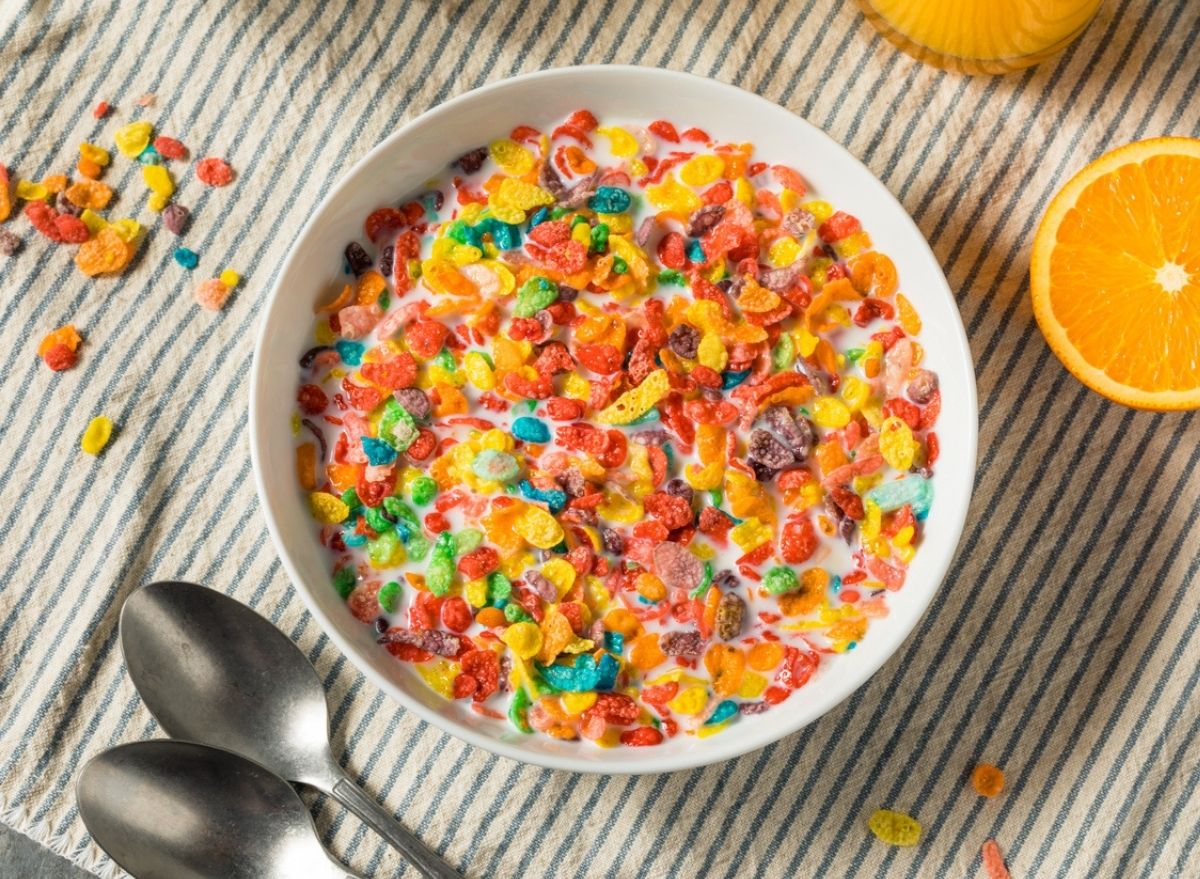
More than 283 million Americans ate cold cereal in 2020, according to a Statista report, and about 43 percent of cereal eaters tend to eat it as a snack, per a Mintel report. It’s safe to say that cereal is a staple in our diets, but is cereal healthy, or should we choose something else for our breakfast or snack?
The answer is a bit nuanced, and oftentimes it depends on the type of cereal you choose, which is why choosing a nutrient-dense option is important. “Remember, while cereal can be a quick and convenient food option, it’s essential to choose wisely and be mindful of portions to enjoy it as part of a balanced diet,” says Danielle Crumble Smith, RDN, LDN, a dietitian with Top Nutrition Coaching. For instance, look for cereal brands that are low in added sugar and higher in fiber and protein.
Also, eating cereal on its own without any other nutritious foods paired with it can limit you. “Over-relying on cereal as a primary food source can lead to an imbalance in nutritional intake and potentially missing out on essential nutrients provided by more varied, whole-food-based meals,” Smith says.
So if you sit down to a bowl (or handful) every day, choosing a nutrient-dense cereal can make the difference between feeling satiated and energized versus hungry and tired. But first, let’s look at some of the potential benefits and side effects of eating cereal regularly.
Read on to learn what happens to your body when you eat cereal every day. And if you are spooning into a bowl, make sure to choose these 9 Best Healthy Cereals on Grocery Shelves, According to Dietitians.
You might feel energized (but not for long).
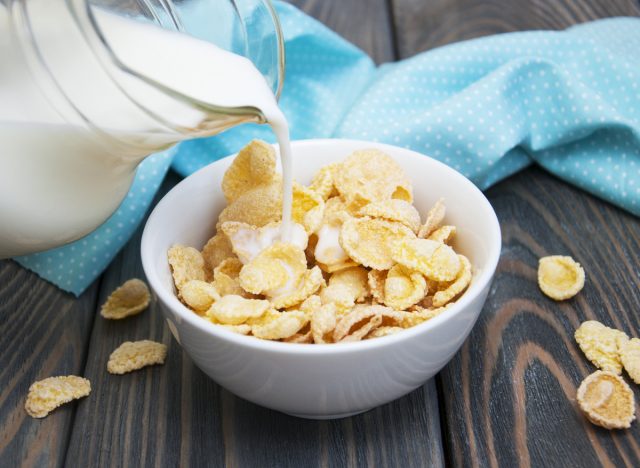
Many cereals are made of refined grains, which are essentially whole grains with the outer shell stripped off. This process makes the grains softer, more uniform, and easier to mold into consistent shapes. But removing the outer part of the grain removes much of the fiber content along with other nutrients, and less fiber means less work for digestion, and the process of converting carbohydrates to energy takes place more rapidly, giving you a quick hit of energy, says Annette Snyder, RD, a dietitian with Top Nutrition Coaching.
That can be a good or bad thing. A source of quick energy can be beneficial if you’re planning to work out shortly after. Eating something with higher fiber (and fat) content before endurance or high-impact exercise can result in digestive discomfort and can delay the release of the stored energy from the carbohydrates, which could affect the quality of your workout, Snyder says.
If you’re not planning to work out after eating a bowl of cereal, consider choosing a breakfast with balanced amounts of fiber, protein, and fat. “These are all key components to sustaining your energy levels over several hours, versus only simple carbohydrates (like those from refined-gain cereals),” Snyder says. “There isn’t much work needed for the body to get at the stored energy in simple carbohydrates, and they will hit your system and be gone in a much shorter time frame.” And that translates to an energy crash.
If your cereal is high in sugar and low in protein and fiber, it can cause your blood sugar to spike and then crash. “The spike and subsequent crash in blood glucose levels can lead to fluctuations in energy levels, making you feel energetic shortly after eating but tired and lethargic later,” Smith says.
Your blood sugar levels may rise and then crash.
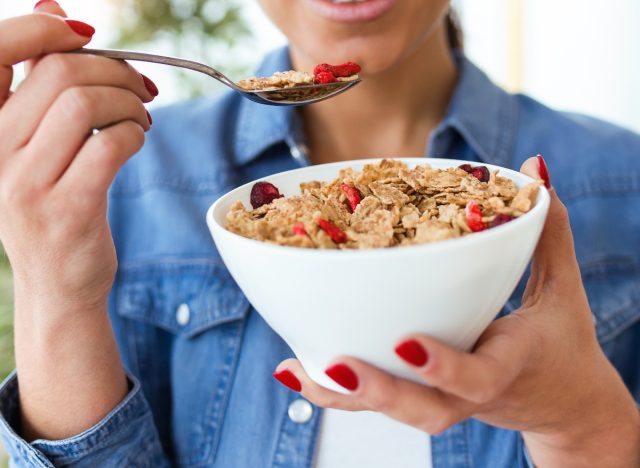
Cereals get a bad rap because they’re often loaded with sugar. “When you consume a sugary cereal, the sugar and refined grains it contains are quickly digested and absorbed into your bloodstream, which results in a rapid rise in blood glucose levels,” says Crumble.
In response to the surge in blood sugar, your pancreas releases insulin, a hormone that helps cells take in glucose for energy or storage, which helps lower blood glucose levels. If the initial surge in blood glucose is too rapid and large (as is often the case with high-sugar foods), the subsequent insulin response can be so robust that it drives blood glucose levels down too rapidly. This can lead to a sudden drop in energy, or a “crash,” which is often characterized by feelings of fatigue, irritability, and hunger, Smith says.
A rapid rise and drop in blood sugar can also contribute to insulin sensitivity. “Over time, regular consumption of high-sugar foods can lead to increased insulin release, which may reduce the sensitivity of cells to insulin,” Smith says. This can increase the risk of type 2 diabetes.
To help prevent a blood sugar rollercoaster, choose a cereal with as little added sugar as possible. Smith recommends aiming for less than 5 grams of added sugar per serving. “Many cereals marketed as ‘healthy’ or ‘natural’ can still be loaded with sugar,” Smith reminds us. For reference, a serving of Special K Red Berries has 10 grams of added sugar while Honey Nut Cheerios has 12 grams.
You might feel hungry shortly after.
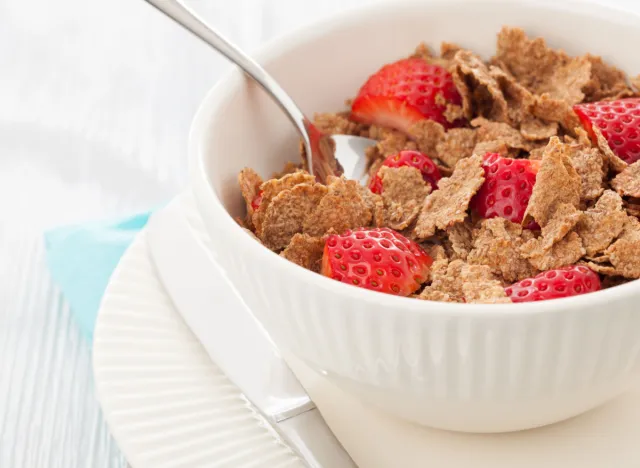
Many cereals are low in fiber and protein, and if the box you pour doesn’t contain enough of these satiating nutrients, eating it first thing in the morning can bring on the cravings. “If you choose a low-fiber cereal, it doesn’t take long for the body to break down those carbohydrates into energy, and it doesn’t take long to leave your stomach, which leads to hunger,” Snyder says.
Instead, you’ll want a cereal that combines fiber, protein, and even some fat from sources like nuts or seeds. “These components all take a little more work for the stomach to break down, meaning they continue to promote fullness for much longer compared to something containing refined grains and little else,” Snyder says. That’s why she recommends looking for a cereal with at least 3 grams of fiber.
As for protein, you’ll want to start your day with about a third of your total daily protein goal, Snyder recommends. So for example, if you’re active and aim to eat 90 grams of protein per day, you’ll want your breakfast to have around 30 grams of protein. “Protein recommendations are more individualized, but starting the day with about 1/3 of your total needs can’t hurt,” Snyder says.
To give your cereal more staying power, pour it over high-protein milk, like dairy or soy milk. Some plant milks contain 1 gram or less protein per serving, so always check the nutrition label, Snyder points out. Also, consider using Greek yogurt as the base for your cereal to add more protein, which leads us to our next point.
You might miss out on protein.
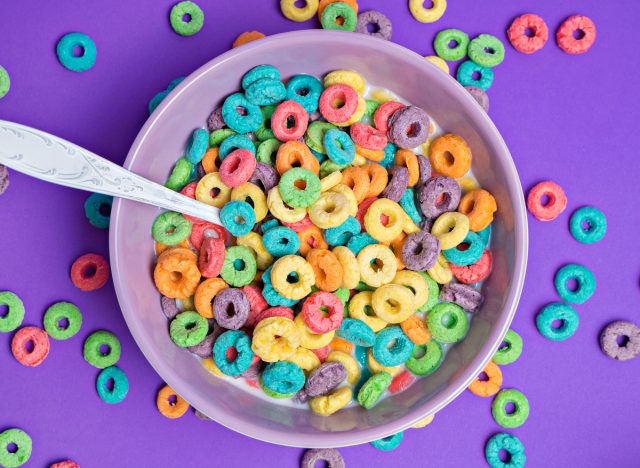
Most traditional cereals are primarily from refined grains and sugars, which are naturally low in protein. “On average, a typical serving of cereal might provide only 1 to 3 grams of protein, whereas a protein-rich breakfast would ideally have at least 20 to 30 grams of protein,” Smith says.
Protein is known to promote feelings of fullness (satiety) more than carbohydrates or fats, per Cambridge University Press. One reason is that protein takes longer to digest than other macronutrients. Another is that, when you consume protein, it leads to the release of certain hormones that signal fullness to the brain, Smith says.
Starting your day with protein can also give your metabolism a boost. “Protein has a higher thermic effect than carbohydrates or fats, which means your body burns more calories digesting and metabolizing protein compared to other nutrients,” Smith says.
What’s more, eating protein in the morning can provide the necessary amino acids for muscle repair and growth, especially if you usually work out in the morning.
Smith generally recommends aiming for 20 to 30 grams of protein at breakfast. “Consuming that much might be tricky to achieve with cereal alone, but swapping milk for Greek yogurt and adding nuts and seeds can certainly help you get close.”
You may end up craving more sugar.

Overeating sugary cereals not only leads to increased calorie consumption but also to excessive sugar intake, which has been linked to various health concerns such as increased risk of type 2 diabetes, heart disease, and dental cavities, Smith says.
As we now know, eating too much sugary cereal leads to a rapid spike in blood sugar, followed by an insulin-driven crash. When blood sugar levels plummet, the body often signals for more quick-energy foods (like carbs) to elevate it again, Smith tells us.
Here’s the science behind why that happens: “Sugar stimulates the release of dopamine, a neurotransmitter associated with pleasure, reward, and motivation in the brain. After consuming sugar, the brain may seek out more of that rewarding feeling, leading to cravings for more sugary or carb-rich foods,” Smith says.
And because sugary cereals usually lack substantial protein and fiber, missing out on these satiating nutrients can cause higher levels of the hunger hormone ghrelin. As a result, “you might find yourself feeling hungry sooner, often wanting more carbohydrate-rich foods,” Smith says.
You might eat more fiber.
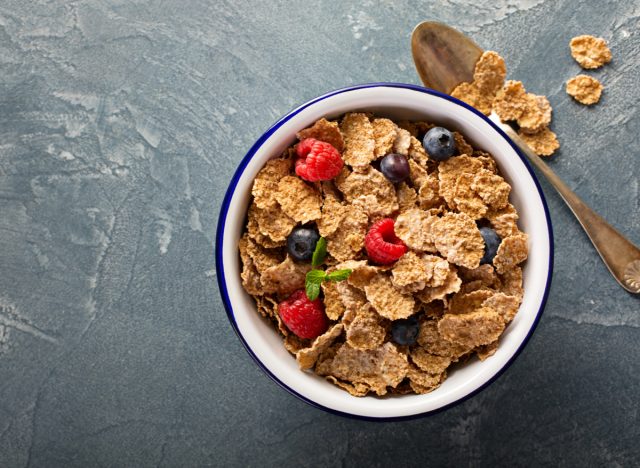
Cereals with higher fiber content from whole grain sources (and nuts and seeds) can serve as great fiber sources. Always look at the nutrition facts on the box, and choose a cereal with at least 3 grams of fiber per serving, Snyder recommends. Also, take a look at the ingredients list: The ingredients should include “whole” listed with any of the grains, like wheat, corn, oats, quinoa, and more, Snyder says. If the ingredient is listed as “refined flour” or “wheat flour” or something akin to that, it’s not a whole grain.
“Eating in the morning provides another opportunity to include fiber, and several types of breakfast cereals offer fiber in an easy-to-eat format,” Snyder says. You can boost your fiber intake even further by pairing your bowl with a serving of fiber-rich fruit, nuts, or seeds.
You may gain weight.
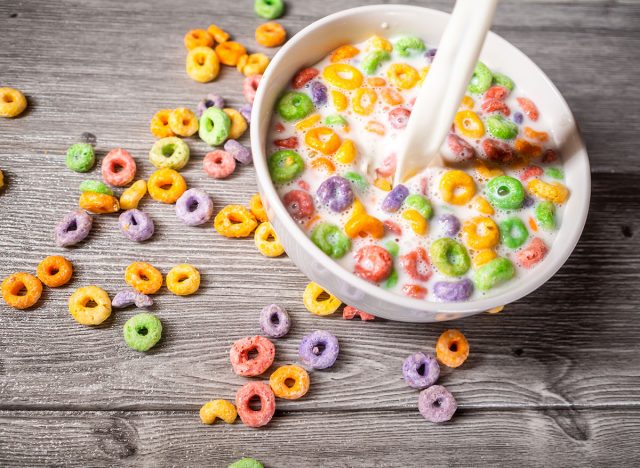
The recommended serving size for most cereals (which is listed on nutrition labels) ranges from 1/2 cup to 1 cup. “However, when people pour cereal into a bowl, especially a large one, they often serve themselves more than this recommended amount, sometimes even double or triple,” Smith says.
“Research has shown that the size of plates, bowls, and utensils can influence how much we serve ourselves and consume,” says Smith. Larger bowls can make a portion look smaller by comparison, leading folks to pour more cereal than they might with a smaller bowl. And when a food (like a cereal that’s rich in refined grains and sugars and low in fiber and protein) doesn’t promote fullness, it can be easy to consume more of it to feel satisfied.
“If you’re consistently consuming more than the recommended serving size, the calories can add up, especially if the cereal is high in sugar and low in fiber. Over time, this can contribute to weight gain,” Smith says.
You’ve heard the cliche, “Everything in moderation.” So make sure to measure out your portions and use smaller bowls. “Especially when trying a new cereal, measure out the recommended portion size to develop a visual sense of how much it is,” says Smith.
Or you might lose weight.
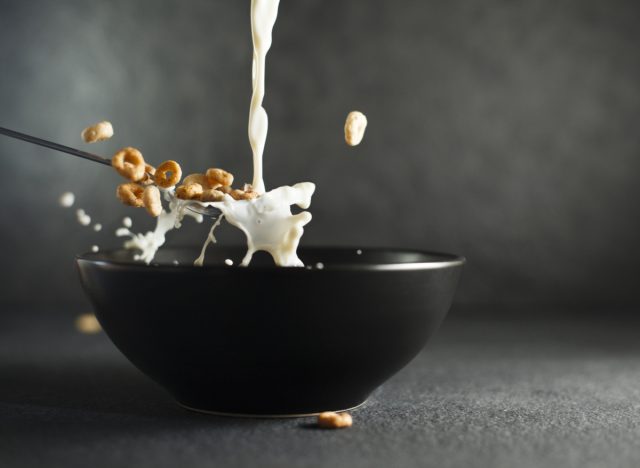
Many studies link eating cereal with weight loss. A 2023 systematic review of both observational studies and controlled clinical settings in Advances in Nutrition found that people who regularly ate breakfast cereal weighed less and had lower BMIs than those who didn’t. These findings were observed regardless of the type of cereal, from high-fiber options to those with refined grains and added sugar, and in a variety of study subjects ranging from children to older adults with varying physical activity levels.
“This [research] did not necessarily compare how well cereal satisfies, controls hunger, its direct effects on blood glucose after the meal, or other outcomes—just weight,” says Snyder. It’s also worth noting that the review was funded by cereal companies including General Mills and Kellogg.
“Considering the findings from the peer-reviewed data noted above, weight gain is no more likely to occur from eating cereals than from eating something like eggs and Bacon,” Snyder says. “However, we know that fiber and protein help manage hunger and blood sugar control, so if one struggles with either of these, consuming a refined-grain cereal with low fiber and protein content could lead to increased hunger and drive to eat more in the hours after.” Still, eating more results in eating more calories, and regardless of the source, too many calories can lead to weight gain.
- Source: https://pubmed.ncbi.nlm.nih.gov/32768415/#:~:text=Conclusion%3A%20Results%20of%20this%20meta,these%20trials%20could%20be%20made.
- Source: https://www.ncbi.nlm.nih.gov/pmc/articles/PMC4258944/
- Source: https://www.ncbi.nlm.nih.gov/pmc/articles/PMC5133084/
- Source: https://bmcmedicine.biomedcentral.com/articles/10.1186/s12916-022-02712-7
- Source: https://www.ncbi.nlm.nih.gov/pmc/articles/PMC4717883/#:~:text=Correlation%20found%20between%20percentage%20of,in%20probability%20of%20developing%20caries.
- Source: https://www.sciencedirect.com/science/article/pii/S0149763418308613
- Source: https://www.ncbi.nlm.nih.gov/pmc/articles/PMC5598018/
- Source: https://www.sciencedirect.com/science/article/pii/S2161831323002995?via%3Dihub